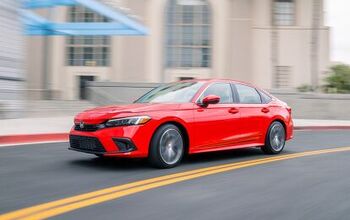Rich People Are Finally Back On Top, Mercedes Takes U.S. Quarterly Sales Honors

Mercedes-Benz had an enviable first-quarter and managed to find itself back on top of U.S. luxury sales, icing out its chief rival BMW after two years of living in its shadow. Mercedes reportedly sold 78,256 vehicles within the first three months of 2021, thanks largely to its crossover vehicles.
It’s a year-over-year increase of 16 percent and helps to explain why the brand is relegating the CLS to a single trim while expanding its options for heavy hitters like the GLC Class. But Mercedes’ recent success may have more to do with the way the luxury segment is rebounding as a whole. As pedestrian models are finding themselves coming out of the pandemic with fewer customers, especially of the subprime variety, high-end luxury brands are enjoying clearer skies.
“There’s a fairly fantastic wealth effect going on,” he told CNN last week.
While the glorious feeling of knowing the rich are getting richer probably doesn’t extend to the single parent that’s trying to scrape together enough dough so their Nissan Sentra doesn’t get repossessed, Jominy’s right. The comeback for luxury brands has been going more smoothly than nameplates catering to regular folks, at least when you’re taking in the big picture. J.D. Power suggested crediting young wealthy people who haven’t had enough to do during lockdowns.
“[The] rich Millennial tech employee in Austin is now the archetype,” Jominy explained.
That terrifying sentence is likely true and probably explains why every brand is dumping billions into development programs designed to deliver the trendiest EV the world’s most brilliant minds can manage. Of course, the majority of the premium brands we have numbers for (Tesla doesn’t like to share) owe almost the entirety of their sales volume to internal combustion vehicles retailing well below six figures. For example, Mercedes’ best seller is the aforementioned GLC and it starts around $44,000. While you can absolutely configure one to surpass $80,000 with a minimum amount of effort, most people aren’t going to run straight to the V8-equipped AMG variant.
But it’s still an aspirational car and that’s where the money is likely to be. People who write code for a living aren’t the ones reeling from modern times. It’s the person who lost just their low-level job at the textile mill, plastics plant, or foundry. Many mainstream automotive manufactures saw quarterly volumes increase by more than double-digit percentage points in America, but they were cut a little deeper by the pandemic this time last year and domestic brands are still struggling rather badly ( partially due to the semiconductor shortage). Dodge fared particularly poorly, losing roughly 28 percent of its previous Q1 volume. Ford only able to claim a 1 percent improvement against the first three months of 2020 and Chevrolet endured a modest, 2-percent sales loss that was offset for General Motors thanks to gains from GMC.
Mercedes’ 78,256 first-quarter sales pale in comparison to their overall volumes, but it still represents a 16 percent (year-over-year) gain for the company without including van sales. Meanwhile, Lexus saw Q1 deliveries improve by 32 percent with 74,253 units and BMW jumped 20 percent with 71,433 cars. Other premium brands also saw noticeable improvements — Acura, Audi, Cadillac, Porsche, and even Buick enjoyed substantial increases in volume against the previous period. This was almost universally supported by extremely high utility/crossover volumes. Even Genesis, which is heavily dependent upon its sedans, saw a whopping 108-percent gain in the first quarter due to the GV80.
Though not every premium name can have a permanent residence in Xanadu. Lamborghini and Ferrari ended 2020 with a bang, however, Rolls-Royce had a terrible year after enjoying a rather solid 2019. Of course, the first quarter of 2021 resulted in Rolls having a 62 percent (year-over-year) global improvement that resulted in its best-ever sales period. That helped to further juice BMW’s worldwide Q1 results of 560,500 deliveries, a 36 percent sales boost from the previous year.
Now seems a good time to be a purveyor of high-end automobiles.
[Image: Franz12/Shutterstock]

A staunch consumer advocate tracking industry trends and regulation. Before joining TTAC, Matt spent a decade working for marketing and research firms based in NYC. Clients included several of the world’s largest automakers, global tire brands, and aftermarket part suppliers. Dissatisfied with the corporate world and resentful of having to wear suits everyday, he pivoted to writing about cars. Since then, that man has become an ardent supporter of the right-to-repair movement, been interviewed on the auto industry by national radio broadcasts, driven more rental cars than anyone ever should, participated in amateur rallying events, and received the requisite minimum training as sanctioned by the SCCA. Handy with a wrench, Matt grew up surrounded by Detroit auto workers and managed to get a pizza delivery job before he was legally eligible. He later found himself driving box trucks through Manhattan, guaranteeing future sympathy for actual truckers. He continues to conduct research pertaining to the automotive sector as an independent contractor and has since moved back to his native Michigan, closer to where the cars are born. A contrarian, Matt claims to prefer understeer — stating that front and all-wheel drive vehicles cater best to his driving style.
More by Matt Posky
Latest Car Reviews
Read moreLatest Product Reviews
Read moreRecent Comments
- Jkross22 When I think about products that I buy that are of the highest quality or are of great value, I have no idea if they are made as a whole or in parts by unionized employees. As a customer, that's really all I care about. When I think about services I receive from unionized and non-unionized employees, it varies from C- to F levels of service. Will unionizing make the cars better or worse?
- Namesakeone I think it's the age old conundrum: Every company (or industry) wants every other one to pay its workers well; well-paid workers make great customers. But nobody wants to pay their own workers well; that would eat into profits. So instead of what Henry Ford (the first) did over a century ago, we will have a lot of companies copying Nike in the 1980s: third-world employees (with a few highly-paid celebrity athlete endorsers) selling overpriced products to upper-middle-class Americans (with a few urban street youths willing to literally kill for that product), until there are no more upper-middle-class Americans left.
- ToolGuy I was challenged by Tim's incisive opinion, but thankfully Jeff's multiple vanilla truisms have set me straight. Or something. 😉
- ChristianWimmer The body kit modifications ruined it for me.
- ToolGuy "I have my stance -- I won't prejudice the commentariat by sharing it."• Like Tim, I have my opinion and it is perfect and above reproach (as long as I keep it to myself). I would hate to share it with the world and risk having someone critique it. LOL.


































Comments
Join the conversation
If you want to see the worst of the US character read what a FOX news trumptard writes.
I would encourage anyone considering purchasing this brand to check out the maintenance costs... As a current owner I can tell you that the bills don't stop when the car is paid off. Ask your dealer what they charge for an "A" and "B" service.